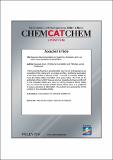Selective depolymerisation of γ-oxidised lignin via NHC catalysed redox esterification
Abstract
The development of new catalytic methods for the processing of lignocellulose‐derived renewable feedstocks continues to gain momentum, despite the considerable challenges associated with the use of complex biopolymers such as lignin. Here, we report a new two‐step depolymerisation method for lignin involving primary alcohol oxidation followed by a NHC‐mediated redox esterification‐depolymerisation step. The process takes advantage of the inherent structure of the β‐aryl ether units present in the specific type of lignin that was used (butanosolv) and delivers 4 novel aromatic monomers which retain the C3 side chain present in the lignin subunits. The utility of the major product is assessed suggesting that rapid access to a wide range of interesting chemical could be achieved from this renewable building block.
Citation
Xiao , G , Lancefield , C & Westwood , N J 2019 , ' Selective depolymerisation of γ-oxidised lignin via NHC catalysed redox esterification ' , ChemCatChem , vol. Early View . https://doi.org/10.1002/cctc.201900787
Publication
ChemCatChem
Status
Peer reviewed
ISSN
1867-3880Type
Journal article
Description
This work was supported by the China Scholarship Council-St Andrews PhD Fellowship (GX). C.S.L. thanks the Leverhulme Trust Early Career Fellowship (ECF-2018-480) and the University of St Andrews.Collections
Items in the St Andrews Research Repository are protected by copyright, with all rights reserved, unless otherwise indicated.

